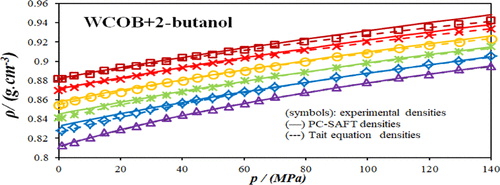当前位置:
X-MOL 学术
›
J. Chem. Eng. Data
›
论文详情
Our official English website, www.x-mol.net, welcomes your
feedback! (Note: you will need to create a separate account there.)
Effects of 2-Butanol Addition on Waste Cooking Oil Biodiesel Density: An Updated Experimental Measurement and Thermodynamic Modeling Study
Journal of Chemical & Engineering Data ( IF 2.0 ) Pub Date : 2021-07-20 , DOI: 10.1021/acs.jced.1c00220 Rachid Aitbelale 1, 2 , Mounia Achak 2 , Younes Chhiti 3 , Natalia Mǔnoz Rujas 4 , Fernando Aguilar 4 , Fatima Ezzahrae M’hamdi Alaoui 2, 5
Journal of Chemical & Engineering Data ( IF 2.0 ) Pub Date : 2021-07-20 , DOI: 10.1021/acs.jced.1c00220 Rachid Aitbelale 1, 2 , Mounia Achak 2 , Younes Chhiti 3 , Natalia Mǔnoz Rujas 4 , Fernando Aguilar 4 , Fatima Ezzahrae M’hamdi Alaoui 2, 5
Affiliation

|
Biodiesels will become the most popular alternative energy resource to fossil diesels; they can be used alone or blended with an oxygenated additive in any proportion. The properties of biodiesels strongly depend on the type of the fatty acid methyl esters (FAME) that compose them. The main objective of the present work is to investigate the influence of 2-butanol addition on the waste cooking oil biodiesel (WCOB), for this fact, the new experimental density data (952 points) of WCOB + 2-butanol binary mixtures over a wide range of composition [seven compositions; 0 ≤ (WCOB) mole fraction x ≤ 1] between 0.1 and 140 MPa and 298.15 and 393.15 K are presented. The experimental data were correlated using Tait and perturbed chain-statistical associating fluid theory (PC-SAFT) equations of state (EoS), to our knowledge, this is the first time that density measurements for the WCOB + 2-butanol mixture are correlated using the famous PC-SAFT EoS. The Tait equation predicts successfully the density with a global absolute average deviation (AAD) of 0.089%, while the PC-SAFT model correlates well the density with a very small global AAD of 0.223% in each composition. Furthermore, contrary to the Tait equation, the PC-SAFT model can explain some interactions between fluid molecules. From the experimental data, the excess volumes VE have been calculated and fitted using the Redlich–Kister equation with a very small global standard deviation of 7.49 × 10–5 cm3 mol–1, and VE show a positive and symmetric parabolic shape in all composition ranges. Finally, the isobaric thermal expansivity, αp, and the isothermal compressibility, κT, have been derived from the Tait equation and their observed trend was as expected.
中文翻译:

添加 2-丁醇对废弃食用油生物柴油密度的影响:最新的实验测量和热力学建模研究
生物柴油将成为化石柴油最受欢迎的替代能源;它们可以单独使用或以任何比例与含氧添加剂混合使用。生物柴油的特性在很大程度上取决于组成它们的脂肪酸甲酯 (FAME) 的类型。本工作的主要目的是研究 2-丁醇添加对废食用油生物柴油 (WCOB) 的影响,为此,WCOB + 2-丁醇二元混合物的新实验密度数据(952 分)超过广泛的成分[七种成分; 0 ≤ (WCOB) 摩尔分数x≤ 1] 在 0.1 和 140 MPa 之间以及 298.15 和 393.15 K 之间。使用 Tait 和扰动链统计相关流体理论 (PC-SAFT) 状态方程 (EoS) 将实验数据关联起来,据我们所知,这是 WCOB + 2-丁醇混合物的密度测量首次关联使用著名的 PC-SAFT EoS。Tait 方程成功地预测了密度,全局绝对平均偏差 (AAD) 为 0.089%,而 PC-SAFT 模型将密度与每个组合中的 0.223% 的非常小的全局 AAD 很好地相关联。此外,与 Tait 方程相反,PC-SAFT 模型可以解释流体分子之间的一些相互作用。从实验数据来看,多余的体积V E已经使用 Redlich-Kister 方程计算和拟合,全局标准偏差非常小,为 7.49 × 10 –5 cm 3 mol –1,并且V E在所有成分范围内都显示出正对称的抛物线形状。最后,等压热膨胀系数 α p和等温压缩系数κ T已经从 Tait 方程导出,并且观察到的趋势与预期一致。
更新日期:2021-08-12
中文翻译:

添加 2-丁醇对废弃食用油生物柴油密度的影响:最新的实验测量和热力学建模研究
生物柴油将成为化石柴油最受欢迎的替代能源;它们可以单独使用或以任何比例与含氧添加剂混合使用。生物柴油的特性在很大程度上取决于组成它们的脂肪酸甲酯 (FAME) 的类型。本工作的主要目的是研究 2-丁醇添加对废食用油生物柴油 (WCOB) 的影响,为此,WCOB + 2-丁醇二元混合物的新实验密度数据(952 分)超过广泛的成分[七种成分; 0 ≤ (WCOB) 摩尔分数x≤ 1] 在 0.1 和 140 MPa 之间以及 298.15 和 393.15 K 之间。使用 Tait 和扰动链统计相关流体理论 (PC-SAFT) 状态方程 (EoS) 将实验数据关联起来,据我们所知,这是 WCOB + 2-丁醇混合物的密度测量首次关联使用著名的 PC-SAFT EoS。Tait 方程成功地预测了密度,全局绝对平均偏差 (AAD) 为 0.089%,而 PC-SAFT 模型将密度与每个组合中的 0.223% 的非常小的全局 AAD 很好地相关联。此外,与 Tait 方程相反,PC-SAFT 模型可以解释流体分子之间的一些相互作用。从实验数据来看,多余的体积V E已经使用 Redlich-Kister 方程计算和拟合,全局标准偏差非常小,为 7.49 × 10 –5 cm 3 mol –1,并且V E在所有成分范围内都显示出正对称的抛物线形状。最后,等压热膨胀系数 α p和等温压缩系数κ T已经从 Tait 方程导出,并且观察到的趋势与预期一致。











































 京公网安备 11010802027423号
京公网安备 11010802027423号